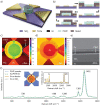Charge Transport Across Au-P3HT-Graphene van der Waals Vertical Heterostructures
- PMID: 36239396
- PMCID: PMC9614726
- DOI: 10.1021/acsami.2c13148
Charge Transport Across Au-P3HT-Graphene van der Waals Vertical Heterostructures
Abstract
Hybrid van der Waals heterostructures based on 2D materials and/or organic thin films are being evaluated as potential functional devices for a variety of applications. In this context, the graphene/organic semiconductor (Gr/OSC) heterostructure could represent the core element to build future vertical organic transistors based on two back-to-back Gr/OSC diodes sharing a common graphene sheet, which functions as the base electrode. However, the assessment of the Gr/OSC potential still requires a deeper understanding of the charge carrier transport across the interface as well as the development of wafer-scale fabrication methods. This work investigates the charge injection and transport across Au/OSC/Gr vertical heterostructures, focusing on poly(3-hexylthiophen-2,5-diyl) as the OSC, where the PMMA-free graphene layer functions as the top electrode. The structures are fabricated using a combination of processes widely exploited in semiconductor manufacturing and therefore are suited for industrial upscaling. Temperature-dependent current-voltage measurements and impedance spectroscopy show that the charge transport across both device interfaces is injection-limited by thermionic emission at high bias, while it is space charge limited at low bias, and that the P3HT can be assumed fully depleted in the high bias regime. From the space charge limited model, the out-of-plane charge carrier mobility in P3HT is found to be equal to μ ≈ 2.8 × 10-4 cm2 V-1 s-1, similar to the in-plane mobility reported in previous works, while the charge carrier density is N0 ≈ 1.16 × 1015 cm-3, also in agreement with previously reported values. From the thermionic emission model, the energy barriers at the Gr/P3HT and Au/P3HT interfaces result in 0.30 eV and 0.25 eV, respectively. Based on the measured barriers heights, the energy band diagram of the vertical heterostructure is proposed under the hypothesis that P3HT is fully depleted.
Keywords: graphene; interface; organic; semiconductor; transport; van der Waals; vertical.
Conflict of interest statement
The authors declare no competing financial interest.
Figures




References
LinkOut - more resources
Full Text Sources
Research Materials

